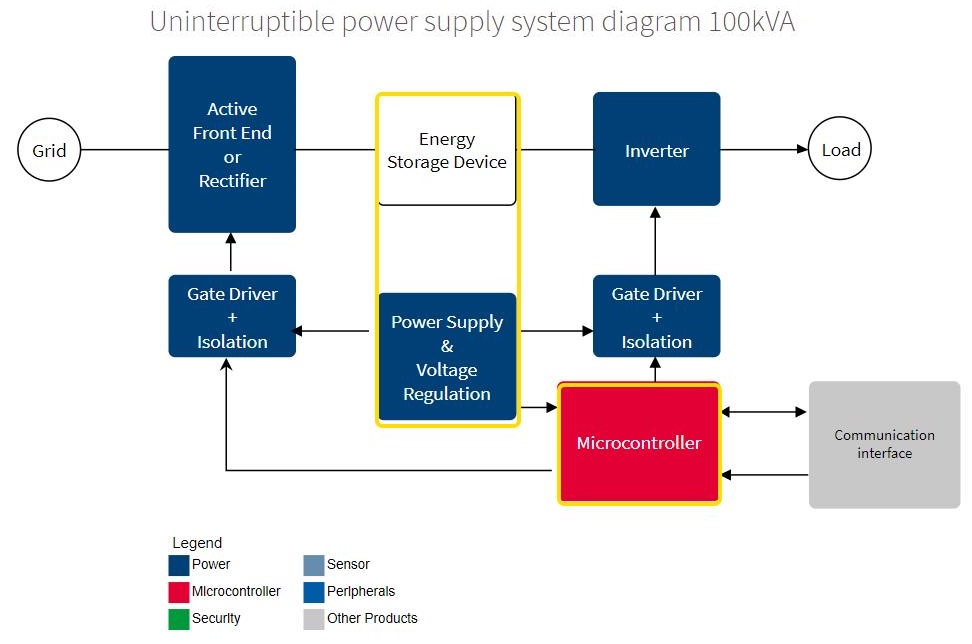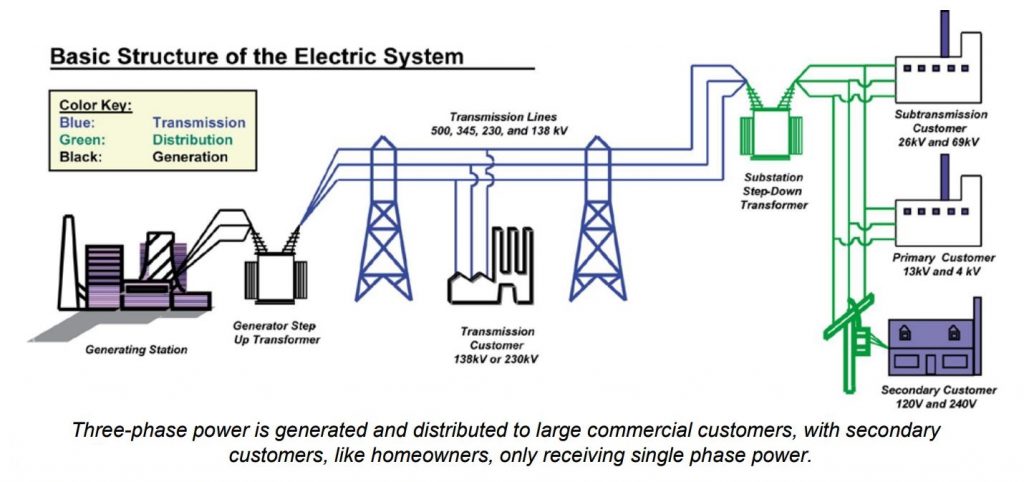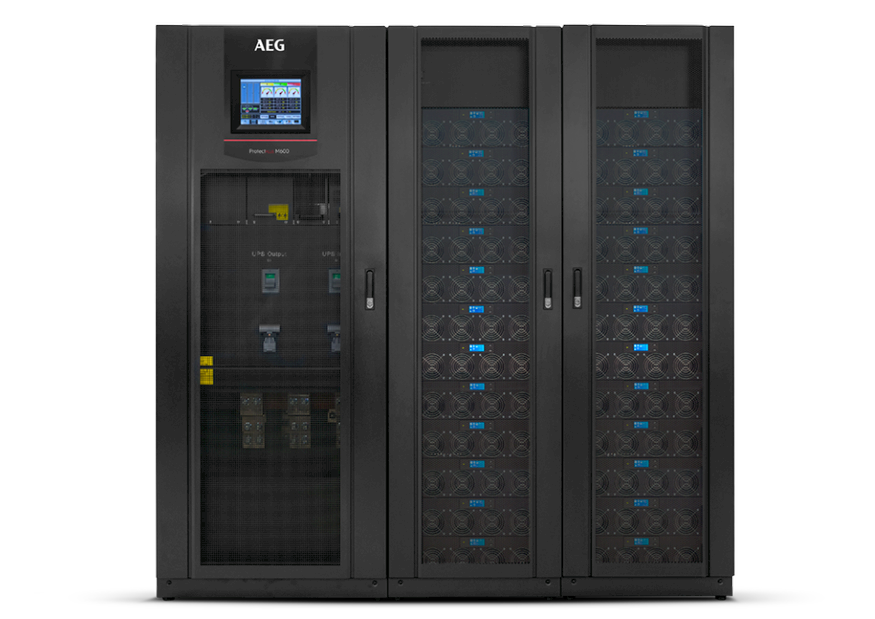One of the most demanded applications for power semiconductors nowadays is an uninterruptible power supply.
An uninterruptible power supply or uninterruptible power source (UPS) is an electrical apparatus that provides emergency power to a load when the input power source or mains power fails. An uninterruptible power supply differs from an auxiliary or emergency power system, or standby generator in that it will provide near-instantaneous protection from input power interruptions, by supplying energy stored in batteries, supercapacitors, or flywheels. The on-battery run-time of most uninterruptible power sources is relatively short (only a few minutes) but sufficient to start a standby power source or properly shut down the protected equipment. It is a type of continual power system.
An uninterruptible power supply is typically used to protect hardware such as computers, data centers, telecommunication equipment or other electrical equipment where an unexpected power disruption could cause injuries, fatalities, serious business disruption or data loss. UPS units range in size from units designed to protect a single computer without a video monitor (around 200 volt-ampere rating) to large units powering entire data centers or buildings. The world’s largest uninterruptible power supply, the 46-megawatt Battery Energy Storage System (BESS), in Fairbanks, Alaska, powers the entire city and nearby rural communities during outages.
Uninterruptible Power Supply Components
General uninterruptible power supply systems are composed of batteries and an inverter that uses IGBT. Power supplies are required to have high reliability and high efficiency.
There are four main components in any online double conversion uninterruptible power supply system: rectifier, batteries, inverter, and static bypass switch.
Rectifier
The rectifier carries out several key functions. The first is to convert the input power from AC (Alternating Current) to DC (Direct Current). Its second main role is to recharge the batteries, while the DC power routes to the inverter too. Depending on the size of the UPS, the rectifier module may incorporate the battery charger. With smaller uninterruptible power supply systems (i.e. below 3 kVA) it is not uncommon for the rectifier and battery charger to be separate components.
UPS rectifiers can accept wide input voltage fluctuations, meaning the system can handle overloads or surges without having to engage the batteries.
Batteries
The batteries in a UPS system provide emergency power when the mains supply fails. Either the rectifier or a separate charger ensures that the batteries are always charged. UPS battery systems have at least one string of batteries, with the number of batteries required depending on the DC voltage of the uninterruptible power supply. Batteries within a string are connected in series, so if a single battery fails, so too does the entire string.
For smaller UPS systems, the batteries are often internal to the unit. Whereas in larger solutions, uninterruptible power supply batteries are often housed in their own standalone cabinets.
Inverter
This component fulfils the second half of the double conversion by switching the DC voltage from the rectifier or battery back to an AC output that powers the critical load.
This conversion process (AC to DC to AC) and filtering smooths out events such as spikes, sags, surges, and electrical noise, ensuring the final output is a pure sine waveform.
Static Bypass Switch
This component is a safeguard in case there’s a failure within the UPS system. In the event of an uninterruptible power supply fault, the static bypass switch automatically connects the load to the mains supply, bypassing the rectifier, batteries, and inverter.
Having to transfer to mains supply isn’t ideal as the power won’t be filtered or conditioned as usual in an online double-conversion UPS, but it does enable equipment to continue functioning while the UPS is repaired or replaced.
Other Components
Depending on the size and type of uninterruptible power supply, there are several other common components that may be included, for example, fans or capacitors.
In addition, there are also components such as an External Maintenance Bypass, which enables the uninterruptible power supply to be removed and/or replaced without interrupting the load, Transient Volt Surge Suppressors (TVSS), and Simple Network Management Protocol (SNMP)-compliant monitoring and communications applications.
Uninterruptible Power Supply Types
Uninterruptible power supplies come in three major varieties, which are also known as topologies.
Single-Conversion Systems
In normal operation, these feed incoming utility AC power to IT equipment. If the AC input supply falls out of predefined limits, the UPS utilizes its inverter to draw current from the battery, and also disconnects the AC input supply to prevent backfeed from the inverter to the utility. The UPS stays on battery power until the AC input returns to normal tolerances or the battery runs out of power, whichever happens first.
Two of the most popular single-conversion designs are standby and line-interactive:
- Standby uninterruptible power supply allows IT equipment to run off utility power until the UPS detects a problem, at which point it switches to battery power. Some standby UPS designs incorporate transformers or other devices to provide limited power conditioning as well.
- Line-interactive uninterruptible power supply regulates input utility voltage up or down as necessary before allowing it to pass through to protected equipment. However, like standby UPSs, they use their battery to guard against frequency abnormalities.
Double-Conversion Systems
As the name suggests, these devices convert power twice. First, an input rectifier converts AC power into DC and feeds it to an output inverter. The output inverter then processes the power back to AC before sending it on to IT equipment. This double-conversion process isolates critical loads from raw utility power completely, ensuring that IT equipment receives only clean, reliable electricity.
In normal operation, a double-conversion UPS continually processes power twice. If the AC input supply falls out of predefined limits, however, the input rectifier shuts off and the output inverter begins drawing power from the battery instead. The UPS continues to utilize battery power until the AC input returns to normal tolerances or the battery runs out of power, whichever occurs sooner. In case of a severe overload of the inverter, or a failure of the rectifier or inverter, the static switch bypass path is turned on quickly, to support the output loads.
Multi-Mode Systems
These combine features of both single- and double-conversion technologies while providing substantial improvements in both efficiency and reliability:
- Under normal conditions, the system operates in line-interactive mode, saving energy and money while also keeping voltage within safe tolerances and resolving common anomalies found in utility power.
- If AC input power falls outside of preset tolerances for line-interactive mode, the system automatically switches to double-conversion mode, completely isolating IT equipment from the incoming AC source.
- If AC input power falls outside the tolerances of the double-conversion rectifier, or goes out altogether, the UPS uses the battery to keep supported loads up and running. When the generator comes online, the UPS switches to double-conversion mode until input power stabilizes. Then it transitions back to high-efficiency line-interactive mode.
Multi-mode uninterruptible power supplies are designed to dynamically strike an ideal balance between efficiency and protection. Under normal conditions, they provide maximum efficiency. When problems occur, however, they automatically sacrifice some efficiency to deliver maximum levels of protection. The end result is that data centers can save tens of thousands a year on energy without compromising data center performance or reliability.
Single Phase vs Three Phase Uninterruptible Power Supplies
When the utility generates power, it is at the three-phase level. This type of power is available to almost all commercial and industrial customers, as they are typically large consumers of power. Three-phase power uses three separate “phase” wires, which allow higher power to be delivered to a single point or load. Most homeowners only have single-phase power available to them, as homes are typically small power users. Single-phase power is delivered through either one- or two-phase wires, which are derived from the utility three-phase power system using transformers.
Single-phase UPSs tend to be a sensible and economical option for simpler, smaller applications with low kVA requirements, which are typically seen in the home, small businesses and in remote or satellite offices where computing power is less than 20,000 VA. Three-phase UPSs are generally the preferred choice for high kVA applications, which are typically more sophisticated and have high compute densities. Large multistory buildings, data centers and industrial facilities protecting high-power processes are typical three-phase UPS customers, as they need to distribute large amounts of power over relatively long distances.
Power Semiconductors In Uninterruptible Power Supply
The trend from power protection to smarter and more efficient UPS systems due to the advancement in new battery alternatives will enable the adaption of UPS systems capable of integrations with the grid in load management and peak shaving features. To do so, bidirectional AC-DC is highly demanded, at the end works as similar to energy storage systems. Beyond, the trend towards modular and prefabricated design, interest towards standardization of equipment is increasing to reduce the equipment costs, shorten delivery and deployment timelines and simplify service and maintenance. General trend example, it’s common to build a UPS system using 50 kVA to 250 kVA sub-power modules, then stack them to create a 1500 kVA UPS solution.
Uninterruptible power supply parts like rectifiers and inverters consist of power semiconductors. In most cases power semiconductor devices like thyristors and IGBTs are used there. However, modern approach to efficiency in everything dictates new rules, and power semiconductor thyristors are being used less in the latest UPS systems. Moreover, many manufacturers of uninterruptible power supplies tend to use hybrid power semiconductors and devices based on silicon carbide.
Almost every major manufacturer of power semiconductors have solutions for uninterruptible power supplies in their portfolio. Some of them offer special design or characteristics features required by UPS companies. Everything depends on the UPS size, power, environment, etc.
Major Manufacturers of Uninterruptible Power Supplies
As I mentioned earlier, uninterruptible power supply business is very popular in modern society. There are hundreds of companies that produce UPS systems for various applications – from home appliances to nuclear power plants. I will list the major manufacturers of uninterruptible power supplies that produce industrial scale systems.
- Eaton Corporation
- Schneider Electric
- ABB
- AEG
- Rockwell Automation
- Emerson
- Fuji Electric
- Toshiba
- Mitsubishi
- Kehua
- Riello
- Socomec
- Vertiv
- Huawei
- TRIPP LITE
- Hitachi Hi-Rel
- Delta Power Solutions
- etc
The global uninterruptible power supply market is principally driven by rapid urbanization and growth in the IT market. In addition, advantages connected with the usage of UPS such as loss limitation to the numerous electrical components & appliances, and maintenance of data on the servers is also an important driver for the uninterruptible power supply market. There is an increasing trend of understanding these systems as an essential power backup device for making work more effectively and efficiently. Technological advancement and the availability of data center rack solutions are also anticipated to foster market growth. The increasing demand for UPS in the residential and commercial sectors will moreover enhance the market growth.
The global uninterruptible power supply market held a value in the range of $10.5 billion to $11.0 billion in 2018. On top that substantial market revenue pocket, the value of the uninterruptible power supply market estimated to grow at a steady CAGR ranging from 3% to 5% during the forecast period of 2019 to 2025.
Though the demands for the uninterrupted power source is incessantly coming from all over the world, the Asia-Pacific region is currently generating the most substantial chunk, with a global demand share ranging from 28% to 32% as of 2018. Moreover, gauging the imminent need for uninterrupted power supply in every industry, the key sector identified by the analyst from where the demands are high is the consumer electronics sector. With a growing CAGR of 4% to 5% in the market forecast period of 2019 to 2025, the consumer electronics industry is expected to yield huge profits to the uninterrupted power supply market.






